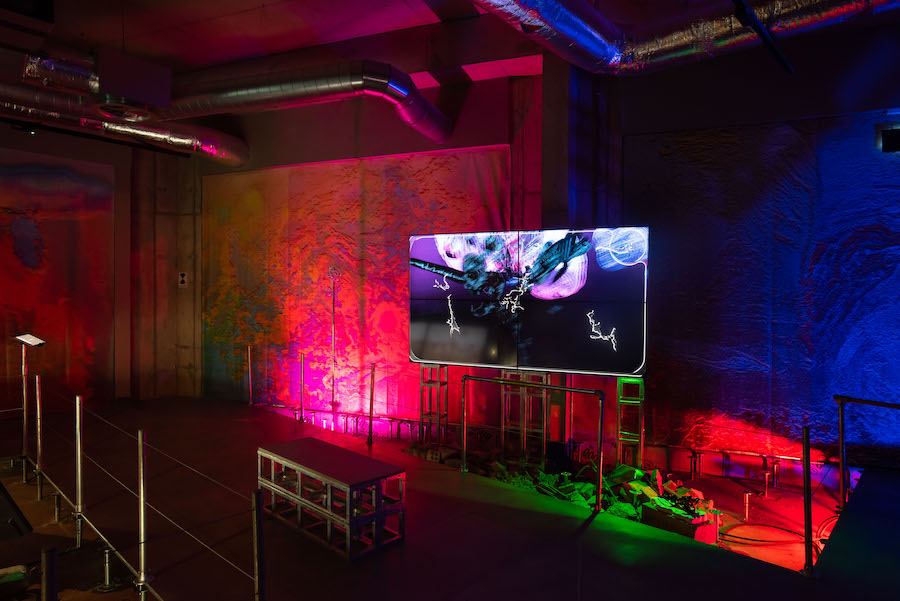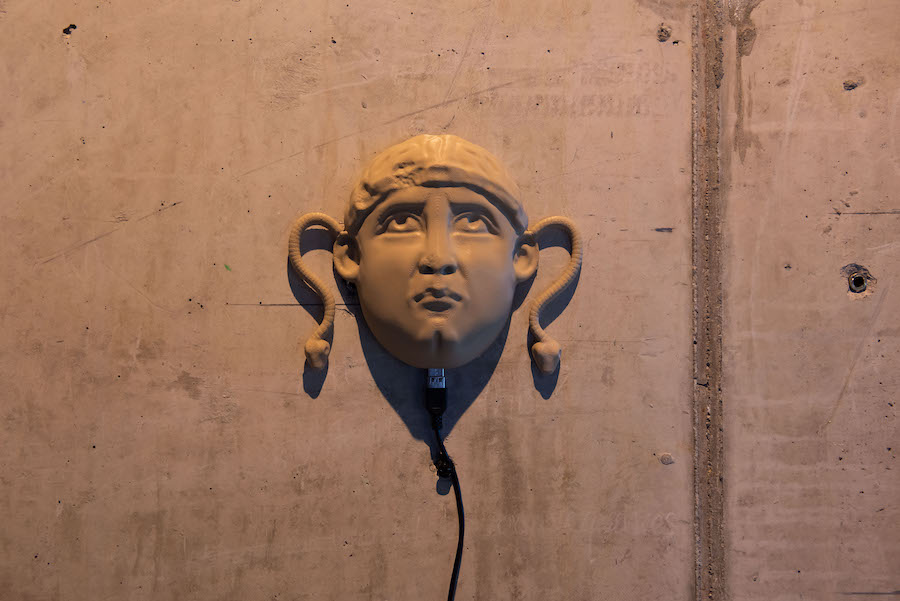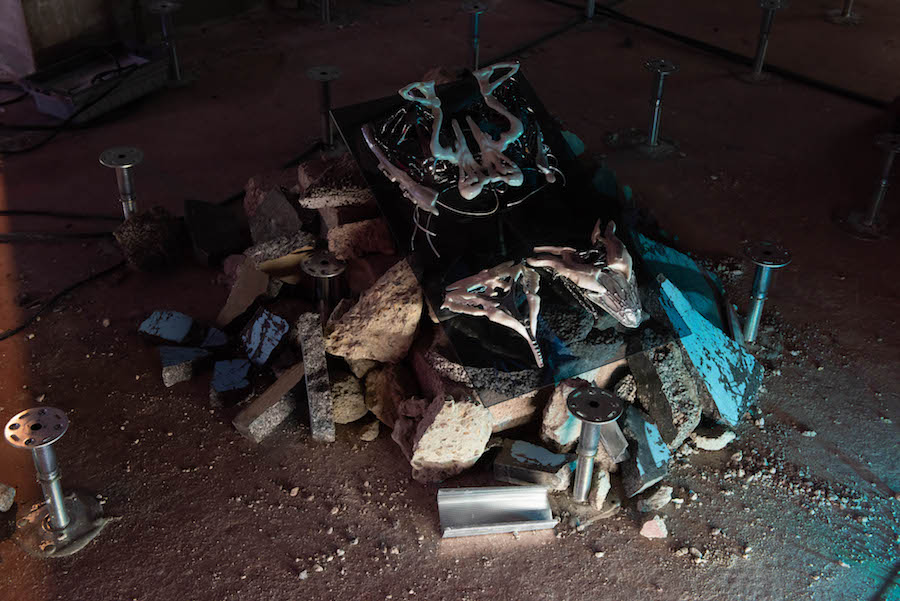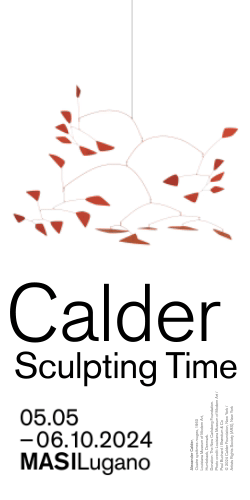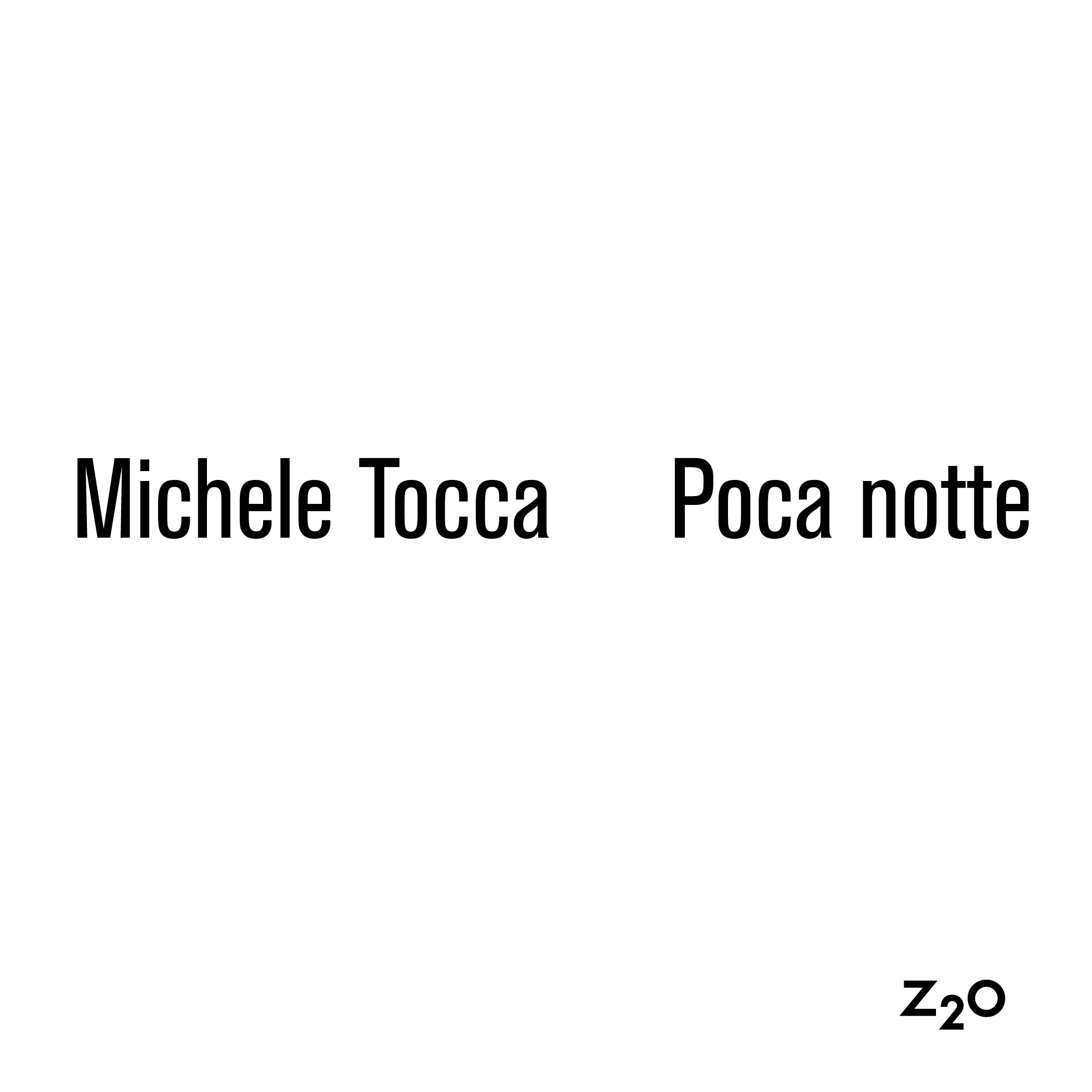

English text below —
Dove finisce il passato e dove inizia il futuro?
Molti pensatori occidentali vedono il tempo come un continuum, con il futuro davanti a noi e il passato alle nostre spalle, unidirezionale, fuori dal nostro controllo, che si dispiega ineluttabilmente – che siamo pronti o meno.
La mostra collettiva Futures Past, in programma presso arebyte a Londra fino al 28 gennaio 2023, ci chiede di riconsiderare questa visione lineare e di aprire la nostra mente a molteplici temporalità. Curata da Rebecca Edwards nell’ambito del programma 2022/23 di arebyte sulla fantascienza, questa mostra si spinge oltre i confini del significato di fantascienza, speculando su concetti come l’ideologia quantistica, le protesi cibernetiche, la performatività dell’identità e la terraformazione digitale.
Non appena ci immergiamo nello spazio buio della galleria, ci rendiamo conto che le reliquie che stiamo vedendo non riguardano il futuro, ma piuttosto il presente. Le opere di dodici artisti (tra cui Lawrence Lek, Kumbirai Makumbe e Shinji Toya) emergono da artefatti digitali e fisici del XXI secolo: monitor, proiezioni, videowall e pannelli LED giacciono sul pavimento a vista mentre ci muoviamo tra le rovine del contemporaneo. Come afferma la famosa scrittrice di fantascienza Ursula Le Guin nella sua introduzione a La mano sinistra delle tenebre, “la fantascienza non è predittiva; è descrittiva”.
Per citare Rebecca Edwards sul significato e le implicazioni legate alla mostra: “Presentare opere tecnologiche tra macerie, oggetti di scarto e polvere è un promemoria non solo della provenienza di questa tecnologia (che deriva da rari minerali che si trovano nelle profondità del sottosuolo), ma anche della sua destinazione (scartata come e-waste, inquinando l’ambiente). Come consumatori di questa tecnologia dobbiamo essere consapevoli che il nostro desiderio di novità ha conseguenze che vanno ben oltre la durata della nostra vita”.
La colonna sonora “Thought Experiment” di Matteo Zamagni costruisce un percorso nel nostro orizzonte sensoriale, inducendo un’atmosfera surreale e inquietante. Riempie lo spazio e lo unifica, trasformando la galleria in un luogo di riflessione, memoria e conservazione.
La prima opera che ha attirato la mia attenzione è un monolite misterioso e colorato: “Critically Extant” di Entangled Others esplora quanto poco sappiamo del mondo naturale, mettendo alla prova i limiti dei dati che ci circondano nell’era digitale. Immagini vagamente pixellate si trasformano rapidamente davanti ai miei occhi, tanto affascinanti quanto sfuggenti. Sono ipnotizzata. Questi algoritmi di intelligenza artificiale sono stati addestrati su milioni di immagini open source del mondo naturale per generare rappresentazioni visive della flora e della fauna in pericolo.

Edwards spiega che “la stessa tecnica di IA chiamata GAN (generative adversarial networks) utilizzata da Entangled Others è presente anche nell’opera ‘Speculative Treasures’ di Juan Covelli, che reimmagina i manufatti Quimbaya che devono ancora essere restituiti alla Colombia da parte della Spagna. In queste opere, la realtà si mescola con l’immaginazione tecnologica per creare risultati liminali”.
Come Juan Covelli, la pratica di Morehshin Allahyari affronta le pratiche coloniali e la proprietà di reliquie e manufatti. Le sue opere stampate in 3D e i suoi video si mescolano con l’IA per criticare la rappresentazione come tecnologia di dominio coloniale sulla natura. Una testa appesa al muro, della serie South Ivan (2018), è una replica tratta da una serie di manufatti distrutti dall’ISIS nell’antica città irachena di Hatra nel 2015. Contiene una chiavetta USB incorporata alla quale i visitatori possono collegarsi per scaricare i materiali di ricerca di Allahyari direttamente sui propri dispositivi.
Le sculture “The Figments” di Kumbirai Makumbe e l’opera “Us and Beyond Us” di Abi Sheng utilizzano narrazioni fantascientifiche con sfumature post-umane e cyborgiane per creare modalità alternative e futuristiche di essere e pensare. “L’idea di reliquia nella mostra è anche qualcosa che viene modellata e trasformata attraverso le pratiche dei vari artisti”, spiega Edwards. “Per Kumbirai Makumbe, la reliquia è sia emancipata dal corpo sia una manifestazione di creazione multimodale; le sculture sono realizzate attraverso la manipolazione fisica dell’argilla, trascritte in digitale e renderizzate con un software, e trascritte nuovamente attraverso il fisico con la stampa 3D e la pittura a mano”.
Scavando e rianimando questi reperti digitali, siamo costretti a confrontarci con un presente che è un “luogo di lotta inquieto e frammentario”: questi dispositivi digitali sono strumenti politici, sociali, economici e tecnologici che ampliano la comprensione del mondo in cui viviamo.
Futures Past fonde la stranezza del passato, del presente e del futuro in un solo tempo, permettendoci di cogliere la fondamentale apertura e indeterminatezza del futuro. Il futuro stesso non si trova nel futuro, ma è invece un aspetto di un presente in continua evoluzione. Immaginare questi tempi come qualcosa di più spirituale e progressivo, piuttosto che lineare e definitivo, potrebbe sconvolgere positivamente lo status quo e offrire un’alternativa al paradigma della crescita illimitata dettata dal cambiamento tecnologico e dall’economia globale.



Futures Past at arebyte, London
This group exhibition, part of the arebyte 2022/23 programme on science fiction, invites us to rethink the notion of time, with past and future continually collapsing and co-inventing each other.
Where does the past end and the future begin?
Many Western thinkers see time as a continuum, with the future ahead of us and the past at our backs, unidirectional, outside of our control, unfolding inescapably – whether we’re ready for it or not.
The group show Futures Past, on view at arebyte in London until 28 January 2023, asks us to re-consider this linear view and open our minds to multiple temporalities. Curated by Rebecca Edwards as part of arebyte’s 2022/23 programme on science fiction, this exhibition pushes the boundaries of what science fiction means today, speculating on concepts such as quantum ideology, cyborgian prosthetics, performativity within identity, and digital terraforming.
As soon as we immerse ourselves in the darkened space of the gallery, we realise that the relics that we are seeing are not about the future but rather about the present. Works by twelve different artists (including Lawrence Lek, Kumbirai Makumbe, and Shinji Toya) emerge from digital and physical artefacts of the 21st century: monitors, projections, video walls and LED panels lie on the exposed floor as we wind our way through the ruins of the contemporary. As famed science fiction writer Ursula Le Guin puts it in her introduction to The Left Hand of Darkness, “science fiction is not predictive; it is descriptive”.
To quote Rebecca Edwards on the meaning and implications related to the display: “Presenting technologically-based works amongst rubble, discarded tech and dust is a reminder not only of where this technology comes from (the rare-earth minerals found deep underground) but also of where it is headed (discarded as e-waste, polluting the environment). As consumers of this technology we have to be aware that our desire for the new has consequences far beyond our lifespan.”
The soundtrack “Thought Experiment” by Matteo Zamagni builds a path into our own sensorial horizon, inducing a surreal, eerie atmosphere. It fills and unifies, turning the gallery into a place for reflection, memory, and conservation.
The first artwork that caught my attention was a mysterious, colourful monolith: “Critically Extant” by Entangled Others explores how little we know about the natural world by testing the limits of the data all around us in this digital age. Vaguely pixellated images morph quickly before my eyes, as alluring as they are elusive. I am almost hypnotised. These AI algorithms were trained on millions of open-source images of the natural world to generate visual representations of species that are critically endangered.

Edwards explains that “the same AI technique called GAN (generative adversarial networks) used by Entangled Others is also present in Juan Covelli’s ‘Specualtive Treasures’ work which reimagines the Quimbaya artifacts that are still to be returned to Colombia from Spain. In these works, reality is morphed with technological imaginings to create liminal outcomes.”
As with Juan Covelli, Morehshin Allahyari’s practice addresses colonial practices and ownership of relics and artefacts. Her 3D-printed and video works mix with AI to critique representation as a technology of colonial domination over nature. A head hanging on the wall, from the South Ivan Series (2018), is a replica drawn from a set of artifacts destroyed by ISIS in the Iraq’s ancient city of Hatra in 2015. It contains an embedded USB drive to which visitors can connect so as to download Allahyari’s research materials directly to their own devices.
Kumbirai Makumbe’s sculptures “The Figments” and Abi Sheng’s work “Us and Beyond Us” use science fiction narratives with post-human and cyborgian hues to create alternative modes of futuristic being and thinking. “The idea of relic in the exhibition is also something that is pulled and pushed around through various artist’s practices”, explains Edwards. “For Kumbirai Makumbe, the relic is both emancipated from the body and a manifestation of multimodal creation; sculptures are made through physical manipulation of clay, transcribed to the digital and rendered using software, and transcribed back through the physical once more by 3D printing and hand painting.”
By excavating and reanimating these digital finds, we are forced to face a present that is a “fraught and fragmentary site of struggle”: these digital devices are political, social, economic, and technological tools that stretch our understanding of the world we inhabit.
Futures Past blends the strangeness of the past, present, and future tenses into one, allowing us to grasp the future’s fundamental openness and indeterminacy. The future itself does not lie in the future but is instead an aspect of an ever-evolving present. Imagining these tenses as something more spiritual and progressive rather than linear and certain could positively disrupt the status quo and offer an alternative to the limitless growth paradigm dictated to us by technological change and the global economy.
